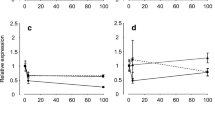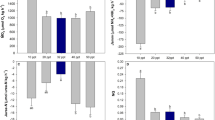Abstract
Laboratory-reared tilapia (Oreochromis mossambicus) were long-term acclimated to freshwater (FW), brackish water (BW, 10‰ salinity), seawater (SW, 35‰ salinity) and two hypersaline media (45 and 60‰ salinity). We examined the influence of these ambient salinities on the density (D cc) and diameter (d cc) of DASPMI-stained chloride cells and on the capacity for electrogenic Cl- secretion of the in vitro opercular epithelium. To provide a characterisation of Cl- secretion, transepithelial potential difference (PD te), conductance (G te) and short-circuit current (I sc) were measured after mounting the respective epithelium in an Ussing-chamber. The cellular electromotive forces (E c) and conductances (G c) as well as the leak conductances (G l) were obtained from G te: I sc plots. In the salinity range between FW and SW both D cc and d cc increased. All electrophysiological parameters recorded increased in parallel, indicating a strong enhancement of the capacity for Cl- secretion on the cellular and epithelial level. In the salinity range above SW a further increase of D cc was observed. However, despite a higher concentration gradient across the body surface of the tilapia during acclimation to hypersaline media, the short-circuit current (I sc) was not significantly different compared to SW preparations. This reflects proportional decreases of G c and increases of E c, respectively. Of particular interest, we found a strong decrease of the leak conductance (G l) in preparations from tilapia acclimated to hypersaline media compared to those from SW fish, indicating that the tight junctions become less permeable.
Similar content being viewed by others
References
Abel, D. C., Koenig, C. C., David, W. P. (1987). Emersion in the mangrove forest fish Rivulus marmoratus: a unique response to hydrogen sulfide. Envir. Biol. Fish. 18: 67–72
Benos, D. J., Sorscher, E. J. (1992). Transport proteins: ion channels. In: Seldin, D. W., Giebisch, G. (eds.) The kidney: physiology and pathophysiology. Raven Press, Ltd., New York, p. 587–623
Bereiter-Hahn, J. (1976). Dimethylaminostyrylmethylpyridiniumiodine (DASPMI) as a fluorescent probe for mitochondria in situ. Biochim. biophys. Acta 423: 1–14
Dange, A. D. (1985). Branchial Na+−K+-ATPase activity during osmotic adjustments in two freshwater euryhaline teleosts, tilapia (Sarotherodon mossambicus) and the orange chromid (Etroplus maculatus). Mar. Biol. 87: 101–107
Degnan, K. J., Karnaky, K. J., Jr., Zadunaisky, J. A. (1977). Active chloride transport in the in vitro opercular skin of a teleost (Fundulus heteroclitus), a gill-like epithelium rich in chloride cells. J. Physiol., Lond. 271: 155–191
Degnan, K. J., Zadunaisky, J. A. (1980a). Ionic contributions to the potential and current across the opercular epithelium. Am. J. Physiol. 238: R231-R239
Degnan, K. J., Zadunaisky, J. A. (1980b). Passive sodium movements across the opercular epithelium: the paracellular shunt pathway and ionic conductance. J. Membrane Biol. 55: 175–185
Epstein, F. H., Silva, P., Kormanik, G. (1980). Role of Na−K-AT-Pase in chloride cell function. Am. J. Physiol. 238: R246-R250
Evans, D. H. (1984a). Gill Na+/H+ and Cl-/HCO3 - exchange mechanisms evolved before the vertebrates entered fresh water. J. exp. Biol. 13: 465–470
Evans, D. H. (1984b). The roles of gill permeability and transport mechanisms in euryhalinity. In: Hoar, W. S., Randall, D. J. (eds.) Fish physiology, Vol. Xb. Academic Press, Inc., Orlando, Florida, p. 239–283
Feldmeth, C. R., Waggoner, J. P. (1972). Field measurements of tolerance to extreme hypersalinity in the California killifish, Fundulus parvipinnis. Copeia 3: 593–594
Foskett, J. K., Hubbard, G. M., Machen, T. E., Bern, H. A. (1982a). Effects of epinephrine, glucagon and vasoactive intestinal polypeptide on chloride secretion by teleost opercular membrane. J. Comp. Physiol. (Sect. B) 146: 27–34
Foskett, J. K., Logsdon, C. D., Turner, T., Machen, T. E., Bern, H. A. (1981). Differentiation of the chloride extrusion mechanism during seawater adaptation of a teleost fish, the cichlid Sarotherodon mossambicus. J. exp. Biol. 93: 209–224
Foskett, J. K., Machen, T. E., Bern, H. A. (1982b). Chloride secretion and conductance of teleost opercular membrane: effects of prolactin. Am. J. Physiol. 242: R380-R389
Foskett, J. K., Scheffey, C. (1982). The chloride cell: definitive identification as the salt-secretory cell in teleosts. Science, Washington 215: 164–166
Hwang, P. P. (1987). Tolerance and ultrastructural responses of branchial chloride cells to salinity changes in the euryhaline teleost Oreochromis mossambicus. Mar. Biol. 94: 643–649
Hwang, P. P. (1988). Multicellular complexes of chloride cells in the gills of freshwater teleosts. J. Morph. 196: 15–22
Isaacson, L. C. (1977). Resolution of parameters in the equivalent electrical circuit of the sodium transport mechanism across toad skin. J. Membrane Biol. 30: 301–317
Karnaky, K. J., Jr. (1972). A system to study the teleost chloride cell with the Ussing chamber. Bull. Mt. Desert Isl. biol. Lab. 12: 60–61
Karnaky, K. J., Jr. (1986). Structure and function of the chloride cell of Fundulus heteroclitus and other teleosts. Am. Zool. 26: 209–224
Karnaky, K. J., Jr., Degnan, K. J., Garretson, L. T., Zadunaisky, J. A. (1984). Identification and quantification of mitochondriarich cells in transporting epithelia. Am. J. Physiol. 246: R770-R775
Karnaky, K. J., Jr., Degnan, K. J., Zadunaisky, J. A. (1977). Chloride transport across isolated opercular epithelium of killifish: a membrane rich in chloride cells. Science, Washington 195: 203–205
Karnaky, K. J., Jr., Ernst, S. A., Philpott, C. W. (1976). Teleost chloride cell: I. response of pupfish Cyprinodon variegatus gill Na, K-ATPase and chloride cell fine structure to various high salinity environments. J. Cell. Biol. 70: 144–156
Karnaky, K. J., Jr., Kinter, W. B. (1977). Killifish opercular skin: a flat epithelium with a high density of chloride cells. J. exp. Zool. 199: 355–364
Keys, A. (1931). Chloride and water secretion and absorption by the gills of the eel. Z. vergl. Physiol. 15: 364–388
Keys, A., Willmer, E. N. (1932). “Chloride secreting cells” in the gills of fishes, with special reference to the common eel. J. Physiol., Lond 76: 368–378
King, J. A. C., Abel, D. C., Di Bona, D. R. (1989). Effects of salinity on chloride cells in the euryhaline cyprinodontid fish Rivulus marmoratus. Cell Tissue Res. 257: 367–377
Kirschner, L. B. (1991). Water and ions. In: Prosser, C. L. (ed.) Comparative animal physiology: environmental and metabolic animal physiology. Wiley-Liss, New York, p. 13–107
Krasny, J. E., Jr. (1981). Ion transport properties of the opercular epithelium of Fundulus grandis. Ph.D. Dissertation, Univ. Miami, Miami, Florida
Kültz, D., Bastrop, R., Jürss, K., Siebers, D. (1992). Mitochondriarich (MR) cells and the activities of the Na+/K+-ATPase and carbonic anhydrase in the gill and opercular epithelium of Oreochromis mossambicus adapted to various salinities. Comp. Biochem. Physiol. 102/2 B: 293–301
Maetz, J. (1970). Mechanisms of salt and water transfer across membranes in teleosts in relation to the aquatic environment. Mem. Soc. Endocr. 18: 3–29
Marshall, W. S. (1977). Transepithelial potential and short-circuit current across the isolated skin of Gillichthys mirabilis (Teleostei: Gobiidae), acclimated to 5% and 100% seawater. J. Comp. Physiol. (Sect. B) 114: 157–165
Marshall, W. S. (1981). Sodium dependency of active chloride transport across isolated fish skin (Gillichthys mirabilis). J. Physiol., Lond. 319: 165–178
Motais, R., Garcia-Romeu, F., Maetz, J. (1966). Exchange diffusion effect and euryhalinity in teleosts. J. gen. Physiol. 50: 391–422
Parry, G. (1966). Osmotic adaptation in fishes. Biol. Rev. 41: 392–444
Silva, P., Solomon, R., Spokes, K., Epstein, F. H. (1977). Ouabain inhibition of gill Na−K-ATPase: relationship to active chloride transport. J. exp. Zool. 199: 419–426
Smith, H. W. (1930). The absorption and excretion of water and salts by marine teleosts. Am. J. Physiol. 93: 480–505
Stickney, R. R. (1986). Tilapia tolerance of saline waters: a review. Prog. Fish Cult. 48: 161–167
Trewavas, E. (1983). Tilapiine fishes of the genera Sarotherodon, Oreachromis and Danakilia. British Museum of Natural History, London
Vökler, T., Jürss, K., Holtz, M. (1987). Na/K-ATPase activity in different tissues of the rainbow trout, Salmo gairdneri RICHARDSON. Zool. Jb. (Abt. allg. Zool. Physiol. Tiere) 91: 457–466
Weber, E. (1986). Grundriss der biologischen Statistik. Gustav Fischer Verlag, Jena
Weisberg, S. B. (1986). Competition and coexistence among four estuarine species of Fundulus. Am. Zool. 26: 249–257
Williams, E. M., Eddy, F. B., Ward, M. R. (1988). Chloride transport and the electrophysiological properties of the isolated skin of the shanny (Blennius pholis L.). J. exp. Zool. 245: 102–105
Yonath, J., Civan, M. M. (1971). Determination of the driving force of the Na+ pump in toad bladder by means of vasopressin. J. Membrane Biol. 5: 366–385
Zadunaisky, J. A. (1984). The chloride cell: the active transport of chloride and the paracellular pathways. In: Hoar, W. S., Randall, D. J. (eds.) Fish physiology, Vol. Xb. Academic Press Inc., Orlando, Florida, p. 129–176
Zeiske, W., Van Driessche, W. (1984). The sensitivity of apical Na+ permeability in frog skin to hypertonic stress. Pflügers Arch. ges. Physiol. 400: 130–139
Author information
Authors and Affiliations
Rights and permissions
About this article
Cite this article
Kültz, D., Onken, H. Long-term acclimation of the teleost Oreochromis mossambicus to various salinities: two different strategies in mastering hypertonic stress. Marine Biology 117, 527–533 (1993). https://doi.org/10.1007/BF00349328
Received:
Accepted:
Issue Date:
DOI: https://doi.org/10.1007/BF00349328




